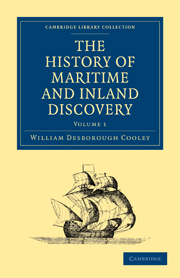Book contents
- Frontmatter
- Contents
- BOOK I GEOGRAPHY OF THE ANCIENTS
- BOOK II GEOGRAPHY OF THE MIDDLE AGES
- BOOK III PROGRESS OF GEOGRAPHY IN THE MIDDLE AGES
- CHAP. I DISCOVERIES OF THE NORTHMEN
- CHAP. II MAPS OF THE MIDDLE AGES
- CHAP. III JOURNEY OF CARPINI INTO TATARY
- CHAP. IV TRAVELS OF RUBRUQUIS
- CHAP. V TRAVELS OP MARCO POLO
- CHAP. VI TRAVELS OF MARCO POLO CONTINUED
- CHAP. VII ODERIC OF PORTENAU
- CHAP. VIII EMBASSY OF CLAVIJO
- CHAP. IX EARLY DISCOVERIES OF THE PORTUGUESE
- CHAP. X THE PASSAGE BY THE CAPE DISCOVERED
CHAP. II - MAPS OF THE MIDDLE AGES
Published online by Cambridge University Press: 05 July 2011
- Frontmatter
- Contents
- BOOK I GEOGRAPHY OF THE ANCIENTS
- BOOK II GEOGRAPHY OF THE MIDDLE AGES
- BOOK III PROGRESS OF GEOGRAPHY IN THE MIDDLE AGES
- CHAP. I DISCOVERIES OF THE NORTHMEN
- CHAP. II MAPS OF THE MIDDLE AGES
- CHAP. III JOURNEY OF CARPINI INTO TATARY
- CHAP. IV TRAVELS OF RUBRUQUIS
- CHAP. V TRAVELS OP MARCO POLO
- CHAP. VI TRAVELS OF MARCO POLO CONTINUED
- CHAP. VII ODERIC OF PORTENAU
- CHAP. VIII EMBASSY OF CLAVIJO
- CHAP. IX EARLY DISCOVERIES OF THE PORTUGUESE
- CHAP. X THE PASSAGE BY THE CAPE DISCOVERED
Summary
The discoveries of the Arabians and Scandinavians in those parts of the earth which were unknown to the ancients remained long concealed from the learned of Europe. Nevertheless the geographical ignorance of the middle ages was not so great as might be concluded from the well-known anecdote of the abbot of Clugny in Burgundy: to him the neighbourhood of Paris seemed a country so remote, and so little known, that he refused to comply with the request of the count de Bourcard, who wished to establish a monastery of his order at St. Maur, near that city. In like manner some monks of Tournai, about the close of the twelfth century, sought in vain to discover the abbey of Ferrières. Thus it appears that the knowledge of the monks sometimes did not extend far beyond the walls of their monasteries.
Yet the monks were almost the only historians of the middle ages; and geography,on the whole, is not a little indebted to their labours. The darkest times and the most barbarous nations of Europe had their treatises of geography, or their chronicles, in which were inserted the descriptions of some countries whether neighbouring or remote. The chronicle of Emon, abbot of Werum, in Groningen, contains on the subject of a crusade (A. D. 1217) a detailed account of the whole march, with a description of all the countries between Palestine and Holland.
But still greater benefits resulted from the labours of the missionaries, who carried the faith to pagan nations, and travelled through countries but little known. Saint Boniface preached to the Sclavonians, and obeyed the injunctions of the pope in giving a written description of those barbarous nations.
- Type
- Chapter
- Information
- The History of Maritime and Inland Discovery , pp. 226 - 241Publisher: Cambridge University PressPrint publication year: 2010First published in: 1830



